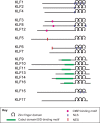Krüppel-like factors in mammalian stem cells and development
- PMID: 28246209
- PMCID: PMC5374354
- DOI: 10.1242/dev.145441
Krüppel-like factors in mammalian stem cells and development
Abstract
Krüppel-like factors (KLFs) are a family of zinc-finger transcription factors that are found in many species. Recent studies have shown that KLFs play a fundamental role in regulating diverse biological processes such as cell proliferation, differentiation, development and regeneration. Of note, several KLFs are also crucial for maintaining pluripotency and, hence, have been linked to reprogramming and regenerative medicine approaches. Here, we review the crucial functions of KLFs in mammalian embryogenesis, stem cell biology and regeneration, as revealed by studies of animal models. We also highlight how KLFs have been implicated in human diseases and outline potential avenues for future research.
Keywords: Cellular regeneration; Human disease; Krüppel-like factors; Mammalian development; Stem cells.
© 2017. Published by The Company of Biologists Ltd.
Conflict of interest statement
The authors declare no competing or financial interests.
Figures





Similar articles
-
The role of Krüppel-like factors in the reprogramming of somatic cells to induced pluripotent stem cells.Histol Histopathol. 2009 Oct;24(10):1343-55. doi: 10.14670/HH-24.1343. Histol Histopathol. 2009. PMID: 19688699 Free PMC article. Review.
-
The critical role of Krüppel-like factors in kidney disease.Am J Physiol Renal Physiol. 2017 Feb 1;312(2):F259-F265. doi: 10.1152/ajprenal.00550.2016. Epub 2016 Nov 16. Am J Physiol Renal Physiol. 2017. PMID: 27852611 Free PMC article. Review.
-
The biology of the mammalian Krüppel-like family of transcription factors.Int J Biochem Cell Biol. 2000 Nov-Dec;32(11-12):1103-21. doi: 10.1016/s1357-2725(00)00059-5. Int J Biochem Cell Biol. 2000. PMID: 11137451 Free PMC article. Review.
-
Role of Krüppel-like factors in cancer stem cells.J Physiol Biochem. 2015 Mar;71(1):155-64. doi: 10.1007/s13105-015-0381-4. Epub 2015 Jan 24. J Physiol Biochem. 2015. PMID: 25616500 Review.
-
Kruppel-like Factors in Skeletal Physiology and Pathologies.Int J Mol Sci. 2022 Dec 2;23(23):15174. doi: 10.3390/ijms232315174. Int J Mol Sci. 2022. PMID: 36499521 Free PMC article. Review.
Cited by
-
KLF6 and STAT3 co-occupy regulatory DNA and functionally synergize to promote axon growth in CNS neurons.Sci Rep. 2018 Aug 22;8(1):12565. doi: 10.1038/s41598-018-31101-5. Sci Rep. 2018. PMID: 30135567 Free PMC article.
-
Pulmonary Mesenchymal Stem Cells in Mild Cases of COVID-19 Are Dedicated to Proliferation; In Severe Cases, They Control Inflammation, Make Cell Dispersion, and Tissue Regeneration.Front Immunol. 2022 Jan 13;12:780900. doi: 10.3389/fimmu.2021.780900. eCollection 2021. Front Immunol. 2022. PMID: 35095855 Free PMC article.
-
Lysophospholipid-Related Diseases and PPARγ Signaling Pathway.Int J Mol Sci. 2017 Dec 16;18(12):2730. doi: 10.3390/ijms18122730. Int J Mol Sci. 2017. PMID: 29258184 Free PMC article. Review.
-
KLF3 promotes the 8-cell-like transcriptional state in pluripotent stem cells.Cell Prolif. 2020 Nov;53(11):e12914. doi: 10.1111/cpr.12914. Epub 2020 Sep 29. Cell Prolif. 2020. PMID: 32990380 Free PMC article.
-
Developing Krüppel-Like Factor 15 Agonists for Kidney Disease.J Am Soc Nephrol. 2024 Oct 1;35(10):1434-1437. doi: 10.1681/ASN.0000000000000417. Epub 2024 May 15. J Am Soc Nephrol. 2024. PMID: 39352761 No abstract available.
References
-
- Agustian P. A., Bockmeyer C. L., Modde F., Wittig J., Heinemann F. M., Brundiers S., Dämmrich M. E., Schwarz A., Birschmann I., Suwelack B. et al. (2013). Glomerular mRNA expression of prothrombotic and antithrombotic factors in renal transplants with thrombotic microangiopathy. Transplantation 95, 1242-1248. 10.1097/TP.0b013e318291a298 - DOI - PubMed
-
- Alhashem Y. N., Vinjamur D. S., Basu M., Klingmuller U., Gaensler K. M. L. and Lloyd J. A. (2011). Transcription factors KLF1 and KLF2 positively regulate embryonic and fetal beta-globin genes through direct promoter binding. J. Biol. Chem. 286, 24819-24827. 10.1074/jbc.M111.247536 - DOI - PMC - PubMed
Publication types
MeSH terms
Substances
Grants and funding
LinkOut - more resources
Full Text Sources
Other Literature Sources
Medical

